The Glories of Lord Ramachandra
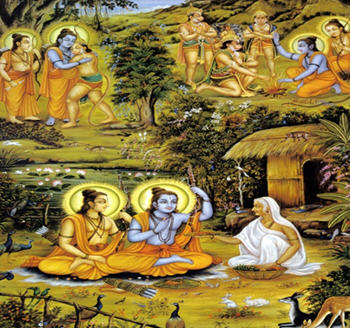
(Back to Godhead article by H.H Satsvarup das Goswami)
Millions of years ago, according to Vedic sources, the Supreme Lord appeared on this planet as the warrior Ramachandra, in order to execute His will and display the pastimes of the Personality of Godhead. As it is stated in the Bhagavad Gita, “From time to time I come, in order to vanquish the demons and rescue the devotees.
The Pastimes of Lord Rama are revealed in the famous vedic scripture called “The Ramayana”, written by Sri Valmiki. Before being empowered to write The Ramayana, Valmiki had been a plunderer; but, by the grace of the great saint Narada, he became a Vaishnava that is, a worshipper of the Personality of Godhead. Narada had first asked Valmiki to please chant the Name of the Lord, but Valmiki had replied that he would not. He was a murderer, and so what had he to do with chanting God’s Name? Narada then asked him to meditate on his murders, by saying the name of “Mara, which means death. Valmiki agreed to this, and meditated on “Mara”. “By rapid repetition of the word Mara, Mara, Mara he found himself saying Rama, Rama, Rama, and by the power of reciting the Holy Name of God, his heart became purified.
The Pastimes of Lord Rama are revealed in the famous vedic scripture called “The Ramayana”, written by Sri Valmiki. Before being empowered to write The Ramayana, Valmiki had been a plunderer; but, by the grace of the great saint Narada, he became a Vaishnava that is, a worshipper of the Personality of Godhead. Narada had first asked Valmiki to please chant the Name of the Lord, but Valmiki had replied that he would not. He was a murderer, and so what had he to do with chanting God’s Name? Narada then asked him to meditate on his murders, by saying the name of “Mara, which means death. Valmiki agreed to this, and meditated on “Mara”. “By rapid repetition of the word Mara, Mara, Mara he found himself saying Rama, Rama, Rama, and by the power of reciting the Holy Name of God, his heart became purified.
The Ramayana is written down as an historical epic, but it contains all the information of the original Vedas. Vedic literature such as The Ramayana and The Mahabharata (of which the famed Bhagavad Gita is a chapter), are especially recommended for this age, even more so than the highly intricate vedas, or the philosophical thesis of the vedanta sutra all of which are prone to misinterpretation by the fallen mentality of this age of quarrel.
So diminished is the capacity for receiving God consciousness in this age that The Bhagavad Gita, which was set down 5000 years ago and was especially intended for the less intelligent, is today not understood by the greatest so-called scholars. These men generally attempt interpretations of the Gita leaving out the importance of the Personality of Godhead, Krishna, Who is the essence, Speaker, and goal of the Gita.
Lord Ramachandra appeared on this earth as a man. This means that He actually walked the earth. What is written in The Ramayana, we should note here, is best understood as it is. When the pastimes of the Supreme Personality of Godhead are narrated, there can be no question of allusion to a higher principle. Allegory means that there is a truth higher than the literal sense of a given text. But the highest realization of spiritual perfection is that the Absolute Truth is a Person which precludes any possibility of going beyond Him. God means the Highest Reality. He is the One from whom everything emanates. Although He appeared as a man out of kindness to His devotees, Ramachandra is the Supreme Lord. His history is, therefore, very marvellous and filled with wondrous feats, as we’ll see.
Ramachandra was the son of King Dasarath, in the line of King Ikshaku, the first ruler of earth, and an early recipient of the Bhakti Yoga system of The Bhagavad Gita. Lord Rama was the darling of His father and mother, Queen Kausalya, as well as the hero and darling of all Ayodha, the capital of what was then the single world kingdom.
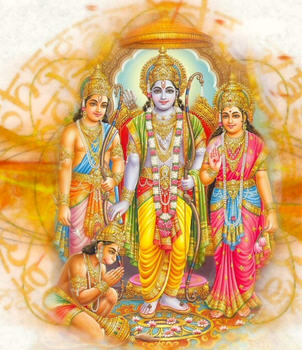
Rama had all the admirable qualities of leadership, even from earliest youth. Ramachandra possessed all physical strength, all beauty, religious wisdom in submission to truth, fame for prowess with weapons, royal wealth, and complete renunciation. He played the part of a human, and yet His stature as a human was praised by all His contemporaries as being worthy of the gods.
Inseparable from Rama was Lakshman, His younger brother. Lakshman was born of Sumitra, one of the 350 queens of King Dasarath. His position is like that of Rama’s Own Self, and nothing is dearer to Rama than Lakshman. Together, the two brothers appeared on earth to vanquish the almost invincible atheist King Ravana and his numberless host of rakshasa (man-eating) warriors.
Inseparable from Rama was Lakshman, His younger brother. Lakshman was born of Sumitra, one of the 350 queens of King Dasarath. His position is like that of Rama’s Own Self, and nothing is dearer to Rama than Lakshman. Together, the two brothers appeared on earth to vanquish the almost invincible atheist King Ravana and his numberless host of rakshasa (man-eating) warriors.
Ramachandra is described as being of greenish hue, His bodily lustre like fresh green grass. And Lakshman is golden-hued. Lakshman is as attractive and as a formidable warrior as Rama Himself. During the course of one of the blood-drenched battles against Ravana’s army, Lakshman was rendered unconscious by rakshasa magic, and at that time Rama gave vent to a spontaneous expression of love for Lakshman: “If I lose kingdom that I can bear, but I could not bear the loss of Lakshman! I cannot go on if Lakshman is lost to Me!“ Lakshman was likewise dedicated to the service of his brother, and had no other pleasure than to please Ramachandra.
Sita, the wife of Rama, is not considered an ordinary being. It is understood that, as Lord Ramachandra was Vishnu, the Supreme Lord Himself, so Sita was actually Lakshmi, the Goddess of fortune, who serves eternally at the feet of Vishnu in the spiritual sky. Being the daughter of the royal saint Janaka, she is also sometimes called Janaki. Actually, Janaka found Sita when she was a baby. He had been plowing a field, and he upturned her in a clod of earth. It is stated in The Ramayana that Sita came to earth for the destruction of Ravana, who was a villifier of married women. As Ramachandra was the greatest warrior and expounder of religion and morality, so Sita was the greatest beauty among women, and the most chaste.
Valmiki compares the sight of Rama and Sita together to the moon and the brightest star. The Ramachandra worshipper, therefore, never makes the mistake of thinking Sita an ordinary wife. Throughout the Ramayana, the poetry again and again turns to images of the various moods of natural beauty in the jungle, in the sky, and in the night with its wonderful galaxies for comparisons to the loveliness of Sita. And always the worshipper addresses first Sita, and then Rama like Sita-Rama.
Kidnapping of Sita by Ravan and Lord Rama’s alliance with the monkeys:
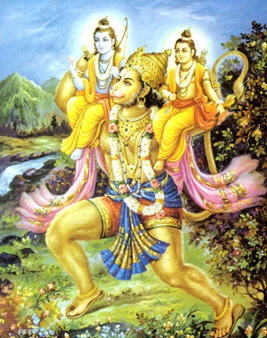
In the absence of Sita, Ramachandra was plunged into unalloyed grief. He was crazed, and His understanding appeared clouded. He was going through the forest asking the flowers and trees if they had seen His wife. He feared that she had been eaten by the rakshasas. He and Lakshman searched everywhere. Rama questioned the sun: “Where has My darling gone? “ He asked the wind if she were dead or alive or stolen, or had he seen her on any path?
Lakshman attempted to draw off Ramachandra’s despair by sensible words, but he was paid no attention. Finally the brothers found signs of Sita, pieces of clothing torn while resisting Ravana, and ornaments which had fallen from her as she rose up in his chariot. They also found the bloodied dying body of Jatayu, the ancient king of birds, who had made a valiant attempt to stop Ravana’s might. Frothing in his last blood, Jatayu informed Ramachandra that it was Ravana, the king of the rakshasas, who had taken Sita. The brothers got further information that they could obtain the help needed to find Ravana’s kingdom by making alliance with Sugriva, the king of the vanaras, a monkey race who lived in the Pampa region of rivers and lakes.
This chief of the monkeys, Sugriva, beholding Ramachandra and Lakshman within his province, was at once fearful. The Vanaras were taking refuge from their enemy Vali, who was the chief’s brother, and Sugriva thought that Rama and Lakshman had come to do some harm, as they appeared so formidable with their weapons. The monkeys ranged from peak to peak, and joined their leader for a conference on what to do about the two mighty young men who were walking amongst the trees and lakes. The chief counsellor to the King, named Hanuman, assured Sugriva that their enemy Vali had no access to the Pampa region. Therefore, why should they fear these two godlike warriors?
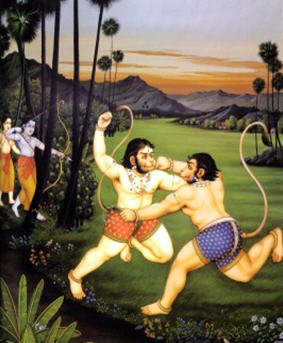
Hanuman approached Rama and Lakshman on behalf of the king, and with eloquent words invited them to meet with the monkey chieftain. Rama was at once delighted with the eloquent speech and appearance of Hanuman, and a meeting was arranged. Seated on giant Sala leaves, Rama, Hanuman, Lakshman and Sugriva spoke out their hearts and concluded a pact of honorable friendship.
Sugriva narrated how he had become confined to this region of the Pampas in fear of his life, having been deprived of his kingdom by his brother Vali. Ramachandra acknowledged that the expression of friendship is good service, and He agreed to kill Vali, who had also abducted the wife of Sugriva. Rama accepted the hand of Sugriva in embrace, and the monkey chief promised to aid Rama in His search for Sita by employing his vast, worldwide army of Vanaras.
Sugriva, however, had some doubts that Rama could actually subdue Vali. In order to assure him, Rama Chandra shot one arrow which traversed through seven palm trees, a rock, through the innermost region of the Earth and in a minute returned to Rama Chandra’s quiver! He then set out, and soon met Vali, and slew him.
After some delay, while Sugriva tasted the sensual pleasures of his regained kingdom, he mobilized his forces and sent them out to all quarters in search of Lanka, where Sita was imprisoned. But after months of futile searching, the armies began to lose hope. Some returned, and some dispersed in foreign lands. It was Hanuman alone who received information that the kingdom of Lanka was an island far across the Indian ocean.
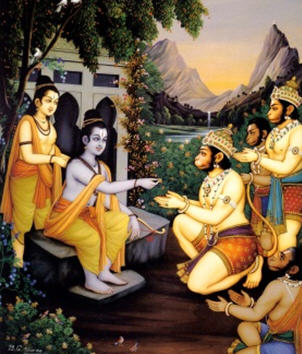
Hanuman is eulogized by all sages and scholars of the vedic science of God, for Hanuman is the ideal servitor. He simply wanted to carry out the order of Ramachandra effectively. His career in finding Sita and battling the rakshasas on behalf of Ramachandra sets the highest spiritual standard, surpassing all mechanical yogic practitioners and speculative philosophers and scholars in search of the Absolute Truth.
It is clearly stated in “Teachings of Lord Chaitanya” by A.C. Bhaktivedanta Swami, that at the last stage the highest spiritual perfection is favorable service unto the Personality of Godhead. The exact example of Hanuman is not to be imitated, but his service attitude is to be followed. That is, each of us has some capacity. Hanuman had the capacity of enormous physical strength and agility. He used every ounce of that strength, not in pursuit of sense gratification or for conquering some land or women, but in humble devotional service to the Lord of the senses, whom he worshipped exclusively as Lord Ramachandra. We should do likewise.
There cannot be any exaggeration in praising the stature and exploits of this formidable monkey warrior. He is not great because he was wonderfully powerful, but because he used all his strength even his anger in discharging service unto the Personality of Godhead in the matter of vanquishing Ravana.
Hanuman resolved to travel through the air in search of Janaki. He was the son of the wind god, Vayu, and thus had the facility for flight. Passage across the ocean is arduous, even for one who can fly like the wind, but Hanuman made it in one leap. His monkey brothers had gathered to watch him off. With a great contraction of strength, Hanuman stood at the edge of the sea and grasped a mountain in his arms. He held his breath and tightened all his limbs. He then spoke these words to his brothers, “I shall reach Lanka with the velocity of the wind, just like an arrow shot by Rama, and if I do not find Janaki there I shall at the same speed go to the region of the gods. And if I do not meet with success even there, then I shall uproot Lanka itself and bring Ravana here in bondage.
“With these words, he sprang up with ease. Like Garuda, the eagle of Vishnu, Hanuman flew over the water, raising great waves by his speed, and exposing the aquatics below, who fled in fear. At times rakshasas rose from the sea for his destruction, but he was not deterred in his mission. Sri Valmiki says that when Hanuman landed in Lanka and went over the city wall, it appeared as if he had planted his left foot on the crown of Ravana.
The perfection of Hanuman in action is open to anyone who will use to the full his own personal capacities in serving the Lord. There is a nice story that occured at the time Ramachandra and the monkeys were building a bridge across the ocean to reach Lanka. Hanuman and the other Vanaras were hefting huge boulders and throwing them into the sea. In the course of such tremendous labor, Hanuman spied an insignificant spider, who appeared to be brushing some specks of dust into the water with its back legs. “What are you doing, worthless?” Hanuman asked of the spider. “I am helping Ramachandra build His bridge” the spider replied.
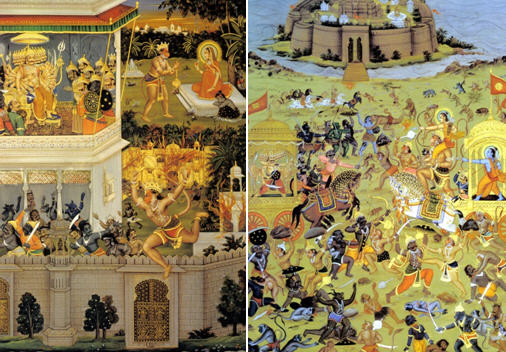
Hanuman was about to move the spider out of the way of his own serious work, when Ramachandra interposed, saying, “What are you doing, Hanuman? This spider is worth as much as you are by doing his utmost for Me.
“The gist of this is that the topmost position of loving service unto God is made manifest by directly applying whatever you have in the way of words, thoughts and energy. And that will be accepted by the Lord as first class devotion.
Lord Ramachandra’s whole program was based on the concept of the ideal king, and it is in that light that we can best understand Him. As the perfect ruler, Ramachandra followed the principles of morality and ethics just as they should be followed by the perfect human king or ruler. Ramachandra submitted Himself to those principles, though He was actually the Supreme Personality of Godhead, and not subject to any moral code. At this instance He showed that a good leader must think only of the welfare of his people, setting aside his entire life for that purpose, with no private pleasures withheld.
A.C. Bhaktivedanta Swami Prabhupada explains the mood of the Lord in His Appearance as Ramachandra: “The comparative studies on the life of Krishna and Ramachandra are very intricate, but the basic principle is that Ramachandra appeared as an ideal king, and Krishna appeared as the Supreme Personality of Godhead, although there is actually no difference between the Two. A similar example is that of Lord Chaitanya. He appeared as a devotee and not as the Supreme Personality of Godhead, although He is Krishna Himself. So we should accept the Lord’s mood in His particular Appearance, and we should worship Him in that mood. Our service should be compatible with the attitude of the Lord. Therefore, in the shastras, there are specific injunctions, such as: The method to worship Lord Chaitanya is chanting Hare Krishna.
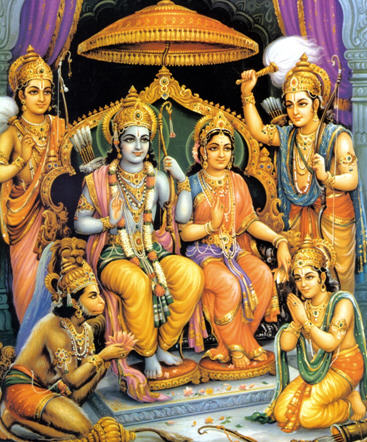
Sri Valmiki declares that he who always listens to this epic becomes absolved from sins. He who listens with due respect meets with no obstacles in life. He will live happily with his near and dear ones, and get his desired boons from Ramachandra, the eternal Vishnu, the Personality of Godhead.